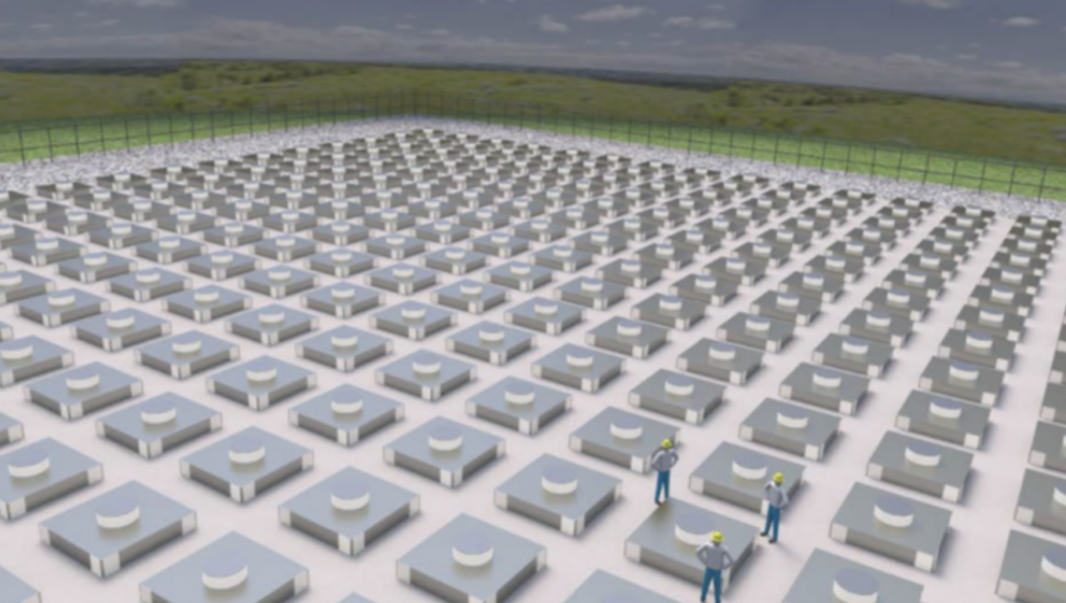
The plan to store radioactive nuclear waste in an uninhabited area of Lea County has been on the drawing board since 2018. In August of that year, Lea County Commissioners passed a resolution (PDF) supporting Holtec International’s efforts to build its Consolidated Interim Storage Facility (CISF) in a remote region of the county. Then again in January of 2023, Lea County Commissioners reaffirmed their backing of the project, unanimously passing a resolution (PDF) “Ratifying a Letter to President Biden Expressing Support” of the proposed nuclear waste storage facility.
A key player in the project, in addition to privately held Holtec International, is the Eddy-Lea Energy Alliance (ELEA). The alliance represents the cities of Carlsbad and Hobbs and the counties of Eddy and Lea. Representing the City of Hobbs as voting members of the alliance are Mayor Sam Cobb and District 1 City Commissioner Finn Smith. Representing Lea County as voting members of the alliance are District 4 County Commissioner Jonathan Sena and Lea County Manager Michael Gallaghar.
Mayor Cobb is additionally listed on the Holtec International website as chairman of HI –STORE CIS Leadership, a group of community and technology leaders “committed to establishing” the nuclear waste storage facility. Former Lea County Commissioner Gregg Fulfer also serves on this leadership team.
According to an Albuquerque Journal article, in addition to bringing the CIS facility to Lea County, Holtec International “…intends to leverage the proposed CISF in Lea County as an opportunity to bring additional economic development to the region.”
Senate Bill 53
In contrast to the support Lea and Eddy counties’ government leaders are giving to the project, some state legislators are taking hands-on steps to block the building of the HI-STORE CIS facility.
SB 53 with the goal of blocking the project passed on New Mexico’s Senate Floor in mid-February. Currently, the bill is progressing through the state House committee process. With a favorable outcome, the bill will move to the full House Floor for debate and vote. If passed SB 53 will go to Governor Michelle Lujan Grisham’s desk for signing into law. As the governor is on record for opposing the CISF project, the likelihood of her signing the bill remains strong.
Sponsored by state Sen. Jeff Steinborn (D – Dist.36), SB 53 requires “…expressed consent from state leaders for any nuclear waste storage site,” states Adrian Hedden in an article he wrote for the Carlsbad Current-Argus. Hedden further notes that the bill “…would also require the federal government [to] have a permanent repository for the waste before a temporary storage site can be built in New Mexico.”
Recent Poll
The San Francisco based polling company Change Research conducted a statewide poll in December 2022, asking New Mexico voters if they favor or do not favor Holtec International’s desire to import “…up to 173,600 metric tons of high-level nuclear waste to southeast New Mexico for temporary storage lasting up to 40 years. In the poll, 60 percent of the 1,015 voters surveyed said they opposed the project, 30 percent supported it and 10 percent were undecided…,” states an article posted at LasCrucesBulletin.com.
On January 10 the poll’s findings were announced in a press release circulated by the Southwest Research and Information Center (SRIC), Southwest Alliance for a Safe Future, Demand Nuclear Abolition and state Sen. Jeff Steinborn.
The poll did not overlook residents of the southeastern part of the state, including Lea County. Unlike claims by the ELEA that residents in this region “…support bringing high level radioactive waste to the area, poll results revealed that a majority – 56 percent – of New Mexico voters residing in the southeast part of the state also oppose the project,” states the press release.
About the poll’s findings Sen. Stienborn stated, “This poll confirms that New Mexicans are overwhelmingly opposed to the shipping and storing of 10,000 canisters of highly radioactive waste into our state. From the very beginning this has been a dangerous plan pushed on New Mexico, with real risks for all of our communities, and no end in sight. It’s time for this project to be canceled, and be replaced by the federal government committing to a true consent based siting process for the permanent storage of this waste.”
Jobs and Income for Lea County
No one doubts the fact that the Holtec project, if approved, will bring high paying jobs – not just one or two but many – to Lea County. According to the Albuquerque Journal, Holtec estimates that the number will be 100 operations jobs and 100 long-term construction jobs, each with an average annual salary of $75,000.
Economic investment in Lea County would also be significant, with Holtec initially making a $150 million capital investment in the county. If all 20 proposed phases of the project were to become a reality, Holtec’s Lea County capital investment is projected to be $3 billion.
Holtec Plans More Than the CIS Facility
Located in conjunction with the Lea County CIS facility, Holtec desires to establish a Worldwide Workforce Training Center. Fifty trainers would prepare “…local workers to handle fuel and conduct dry storage operations in the U.S. and worldwide,” states the Albuquerque Journal. The center would provide opportunities for Lea County residents “… to learn a trade and then travel throughout the nation and the world” … “with high-paying jobs averaging $100,000 a year.”
The Hobbs chapter of the New Mexico NAACP and the Hobbs Hispano Chamber of Commerce would be integral in finding the necessary workforce. In addition to locals, the training center would “… bring workers from U.S. and world-wide utilities to train on Holtec’s technologies, which will provide another opportunity to introduce New Mexico to the nation and world.”
From Holtec’s perspective the proposed CIS facility in Lea County is a down payment on the company’s commitment to bringing green technologies to both southeastern New Mexico and the state as a whole for the benefit of all.
Notwithstanding the fact that a nuclear waste storage plant would bring many, well-paying jobs to the residents of and substantial economic growth to Lea County, many well-founded questions – the project’s impact on public health and the environment, the project’s permanence in the county – remain unanswered. The challenge is deciding what is imperative in the longterm to the future well-being and prosperity of Lea County, southeastern New Mexico and the state as a whole.


